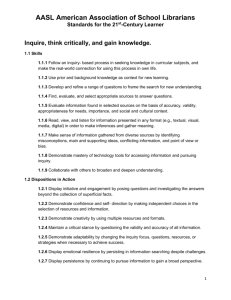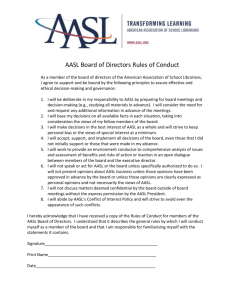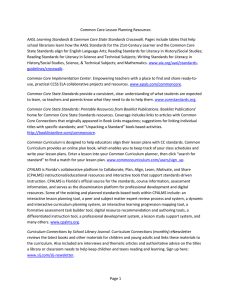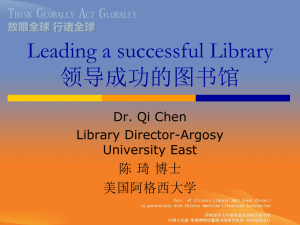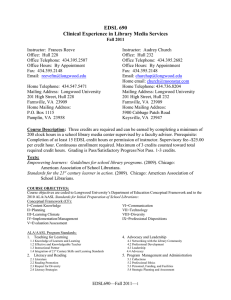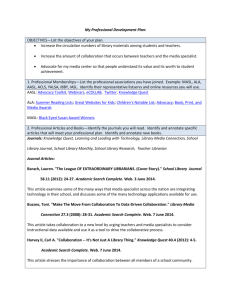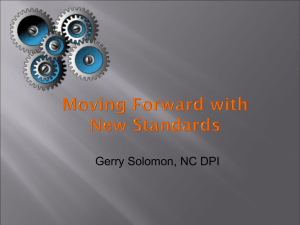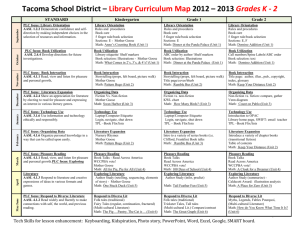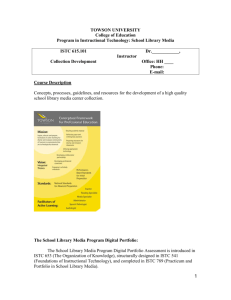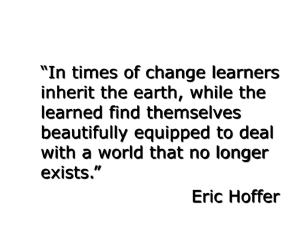AASL BENCHMARKS - West Virginia Library Association
advertisement
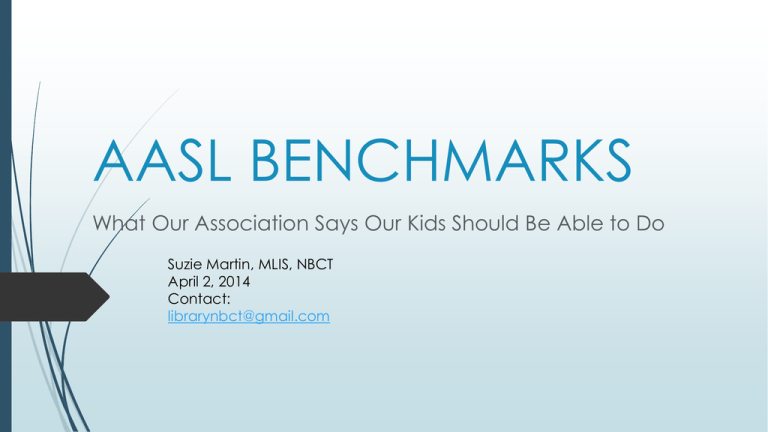
AASL BENCHMARKS What Our Association Says Our Kids Should Be Able to Do Suzie Martin, MLIS, NBCT April 2, 2014 Contact: librarynbct@gmail.com Background 1920 National Education Association (NEA)’s Committee on Library Organization and Equipment publishes standards for senior and junior high schools 1925 Elementary School Library Standards, joint publication of the NEA and the American Library Association (ALA) 1945 School Libraries for Today and Tomorrow* 1960 Standards for School Library Programs* 1969 Standards for School Media Programs,* prepared by the American Standards for School Media Programs,* prepared by the American Standards for School Media Programs,* Association of School Librarians (AASL) and the Department of Audiovisual Instruction (DAVI) of the NEA 1975 Media Programs: District and School, published as a collaborative effort of AASL and the Association of Educational and Communication Technology (AECT) (formerly DAVI) 1988 Information Power: Guidelines for School Library Media Programs, joint publication of AASL and AECT 1998 Information Power: Building Partnerships for Learning, joint publication of AASL and AECT Standards for the 21st Century Learners, 2009. Standards for the 21st Century Learner The Learners: Inquire, Think Critically and Gain Knowledge Draw conclusions, make informed decisions, apply knowledge to new situations, and create new knowledge Share knowledge and participate ethically and productively as members of our democratic society Pursue personal and aesthetic growth Standards for the 21st Century learner Each of the four strands is supported by four subcomponents: Skills Dispositions in Action Responsibilities Self-Assessment Strategies Standard 1: Inquire, Think Critically and Gain Knowledge Nine Skills: Seven Dispositions Five Responsibilities Four Self-Evaluation Strategies Inquiry Process Initiative and engagement Respect intellectual property rights Monitor and adapt information-seeking strategies Background knowledge as context Confidence and selfdirection Seek divergent perspectives Use feedback from teachers and peers Ask questions Creativity Follow ethical and legal guidelines Assess gathered information for weaknesss Evaluate sources Critical stance “Contribute to exchange of ideas within the learning community” Seek appropriate help if needed Evaluate information Adaptability Use technology responsibly Read, view, listen for information Emotional resilience Analyze information for validity and conflict Persistence Use of retrieval tools Collaborate Standard 2: Draw conclusions, make informed decisions, apply knowledge to new situations, and create new knowledge Six Skills Four Dispositions Three Responsibilities Four Self-Assessment Strategies Construct new understandings, draw conclusions, and create new knowledge Show flexibility in the use of various resources “Connect understanding to the real world.” “Determine how to act on information (accept, reject, modify)” “Organize knowledge so that it is useful.” Use divergent and convergent strategies to test new ideas “Consider diverse and global perspectives when drawing conclusions.” “Reflect on process and assess the completeness of the investigation.” Use technology and other tools to organize information Judge conclusions with a critical stance “Use valid information and and reasoned conclusions to make ethical decisions.” Recognize new information and understandings. Apply new knowledge to curricular areas, real-world situations and further investigations. “Demonstrate personal productivity by completing products to express learning.” Collaborate to exchange ideas and create new understandings “Use the writing process, media and visual literacy and technology skills to create products that express new understandings. Develop directions for future investigations. Standard 3: Share knowledge and participate ethically and productively as members of our democratic society Six Skills Three Dispositions Seven Responsibilities Three Self-Assessment Strategies Share and reflect on new understandings and learning Show leadership and confidence in sharing new information Solicit and respect diverse perspectives while searching, collaborating, and sharing Assess the learning process so that one can learn more effectively in the future. Participate and collaborate as a social network of learners “Show social responsibility by actively engaging with the learnings of others by asking questions and contributing ideas.” Respect varying viewpoints, interests, and experiences and seek a variety of viewpoints. Assess the quality and effectiveness of the learning product. Use writing and speaking skills to communicate new learning effectively Demonstrate teamwork by working productively with others Use skills and dispositions to engage in public conversation and debate around issues of common concern. “Assess own ability to work with others in a group setting by evaluating varied roles, leadership and demonstration of respect tor other viewpoints. Use technology and other tools to organize and display new knowledge in ways others can view, use and assess Create products that apply to real-world contexts Connect learning to community issues Contribute the exchange of ideas in and beyond the learning community. Use information and technology ethically and responsibly Use knowledge and information in service to democratic values Respect intellectual freedom Standard 4: Pursue personal and aesthetic growth Eight Skills Four Dispositions Four Responsibilities Six Self-Assessment Strategies Read, view and listen for personal pleasure and growth Display curiosity by exploring interests in a variety of formats Participate in the social exchange of ideas, both electronically and in person Identify own areas on interest Read widely and fluently to make connections to the world and previous reading Demonstrate motivation to find answers to questions of personal interest and display a willingness to go beyond requirements Recognize that resources are created for a variety of purposes Recognize limits on one’s own personal knowledge Respond to literature and creative expressions of ideas in various formats and genres Be willing to change ideas and opinions when evidence points to change. Seek opportunities for personal and aesthetic growth. Recognize how to focus efforts in personal learning Seek information for personal learng in various formats and genres Show an appreciation for literature by electing to read for pleasure and expressing an interest in a various literary genres. Practice safe and ethical behaviors in personal electronic communication and interaction. Interpret new information based on cultural and social context. Connect ideas to interests and previous knowledge and experience. Develop personal criteria for gauging how effectively our own ideas are expressed. Organize personal knowledge in a way that it can be easily accessed. Evaluate own ability to select resources that are engaging and appropriate for personal interest, and interest needs. Use social networks and information tools to gather and share information Use creative and artistic formats to express personal Standards are Benchmarked at Grades 2, 5, 8,10 and 12 Here is a look at how one indicator progresses through each grade level: Other than AASL, what standards applicable to SLMS? • Library Media Content Standards and Objectives for West Virginia Schools (2520.17) • West Virginia Board of Education Policy 2520.14 21st Century Learning Skills and Technology Tools Content Standards and Objectives for West Virginia Schools • Common Core State Standards • AASL Crosswalk to the Common Core Where Do We Go From Here? As an association, we must continue to push for legislation that ensures every school has a certified LMS. Of the more than 700 schools in the state, only 46% have the services of even a half-time library media specialist. As professional educators and librarians, we must embrace the following AASL documents and reference them in our discussions with teachers, administrators, the general public, parents: • Standards for the 21st Century Learner (AASL, 2009) • Standards for the 21st Century Learner in Action (AASL, 2009) • Empowering Learners: Guidelines for School Library Media Programs (AASL, 2009) • A 21st Century Approach to School Librarian Evaluation (Patricia Owen for AASL, 2012) Works Cited Empowering Learners: Guidelines for School Library Programs. Chicago, IL: American Association of School Librarians, 2009. Print. "English Language Arts." American Library Association. American Association of School Librarians. Web. 01 Apr. 2014. Owen, Patricia. A 21st-century Approach To: School Librarian Evaluation. Chicago, IL: American Association of School Librarians, 2012. Print. Pearlman, Bob. "Students Thrive on Cooperation and Problem Solving." Edutopia. George Lucas Educational Foundation, 18 Oct. 2006. Web. 26 Sept. 2012. <http://www.edutopia.org/new-skills-newcentury>. "Preparing America's Students for Success." Common Core State Standards Initiatives. Council of Chief State School Officers (CCSSO) and National Governors Association Center for Best Practices (NGA Center), 2014. Web. 30 Mar. 2014. Standards for the 21st-century Learner in Action. Chicago, IL: American Association of School Librarians, 2009. Print. Standards for the 21st Century Learner. Chicago: American Association of School Librarians, 2007. Print. "State Board Policies." WVDE Policies. West Virginia Department of Education. Web. 01 Apr. 2014.2520.14 Learning Skills and Technology Tools 2520.17 Library Media Content Skills and Objectives for West Virginia Schools
